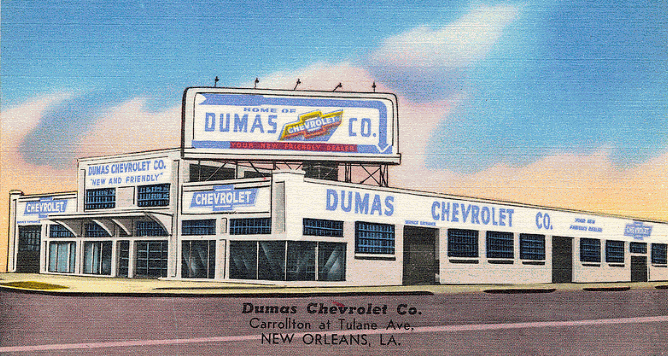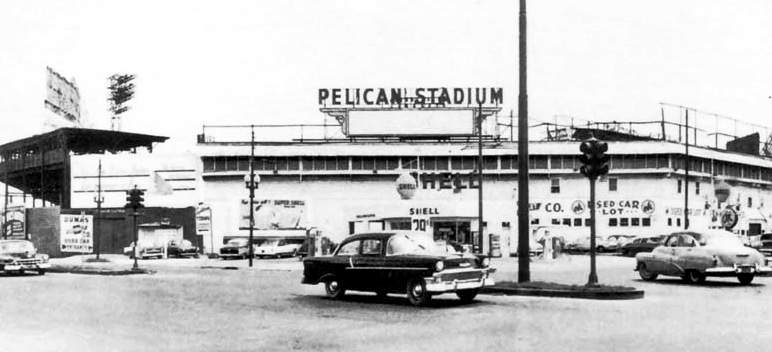|
Today in New Orleans History |
|
|
August 30


 To receive an update for each day in New Orleans history,
join our facebook page - Today in New
Orleans History.
The Causeway Opens  To receive an update for each day in New Orleans
history, join our facebook page
- Today in New Orleans History
Shouting "Bring Back American Jobs to America" and anticipating layoffs, 30 local employees to
form a picket line outside of the telephone company's Central Office in the Central Business on August 29, 1985. They circulated
a petition urging Congress to help preserve jobs. Their actions followed American Telephone and Telegraph's 1,877 job
cut in Shreveport earlier in the month while the company established a facility in Singapore to produce residential phones
which had been manufactured in Shreveport. AT&T was planning to cut an additional 24,000 jobs in their Information Systems
Division -- jobs handling residential and some business services. The president of the local chapter of the Communications
Workers of America (which represented both At&T and South Central Bell workers) said that 50 local jobs could be cut.
AT&T spokesperson Linda Morton said, "It should be obvious to the public that the telephone industry is a terrifically
competitive one. We have an obligation to balance concerns with the need to be competitive and profitable.", reported
the Times-Picayune on August 30, 1985.
Local Investors behind Venture International Group, headed by Gerald A. Derks, reached a conditional agreement
with the New Orleans Exhibition Hall Authority (which manages the New Orleans Convention Center) to lease city owned land
used for the 1984 World's Fair to be developed into an entertainment complex. Venture planned to lease the land and
property between the former Canadian Pavilion (including the IMAX theater) and the Australian pavilion according to
an August 30, 1985 Times-Picayune article. The Exhibition Hall Authority board voted to lease the property
from the city and then rent it to Venture which had been trying to broker the deal during the past year. The agreement
awaited approved by the City Council. Venture also proposed to establish a riverfront music festival similar to Jazz
Fest and sought to lease Pontchartrain Beach for development.
Robert Ernest "Dumas" Milner, who owned Dumas Chevrolet Company, was the Tom Benson of Jackson,
Mississippi -- a self-made millionaire who made a fortune through turning small companies into large profitable ones, opening
car dealerships, buying and selling real estate, and generally making everthing he touched turn to gold. "Dumas"
was a nickname given his after he began following a hired hand by that name around his family's cotton farm. At age 7 he hawked
Rosebud Salve elixir to his rural neighbors. As a young man he took over Magnolia Chemical Company who employed six peope
to produce their patented Pine-Sol and other cleaning products, and turned it into a $10 million per year company with 86
warehouses, and sold it to American Cyanamid for $17 million. He bought hotel and real estate, owned the tallest building
in Jackson, began an exporting business, and acquired National Car Rental. He was Chief of Staff of Mississippi Governor John
Bell Williams and owned Henderson Mansion in Pass Christian. With a somewhat quirky (but true to his times) business philosophy,
he refused to hire a man to a key position until he met the man's wife. When the Dumas dealership
formally opened at 4049 South Carrollton on August 30, 1952 at 8 a.m., gifts were given to the ladies and
Val Barbara and his Orchestra played. The air-conditioned showroom was modern in every way. The repair shop was stocked
with $50,000 worth of parts and equipment. Thirty-five employees were on duty, with 80 more expected to be brought on
during the next six months. Ben Howard Nelson was the vice-president and general manager, W. N. Newt Godfree was the GM, Herbert
P. Jackson served as service manager, S.K. Martin the business manager, J. Clyde Carter was in charge of parts, Alex Holliday
was truck manager, and Henry Carter was the used car head man. By the time the dealership celebrated its second anniversary,
it had added a used car lot at 3925 South Carrollton. By 1956, Dumas had four dealerships in New Orleans, including
locations at 215 South Claiborne (between Tulane and Canal) and in Kenner at Airline Highway at Clay Street. The beloved Pelican Stadium has a long history of its own (much too long to feature here) but for
baseball fans, this sight (right) must have been heartbreaking. On October 16, 1956, Dumas announced the opening of
a new car lot at Pelican Stadium. A want-ad published in the Times-Picayune that day sought new and used car salesmen
to work it..."Apply in person to Bill Watson". From 1915 the New Orleans Pelicans (the
first professional sports team in New Orleans) called it home, as did the Black Pelicans and the Creole Negro teams.
Pelican/Heinemann Stadium also allowed local fans to view major league exhibition and training games and to get a glimpse
of stars such as Babe Ruth, Jackie Robinson, and Hank Aaron. The stadium was demolished in 1957. It was replaced
by the Fontainebleau Hotel which was was later converted into a storage facility.
|
|
|

To receive an update for each day in New Orleans history,
join our facebook page - Today in New
Orleans History.
Analytics |
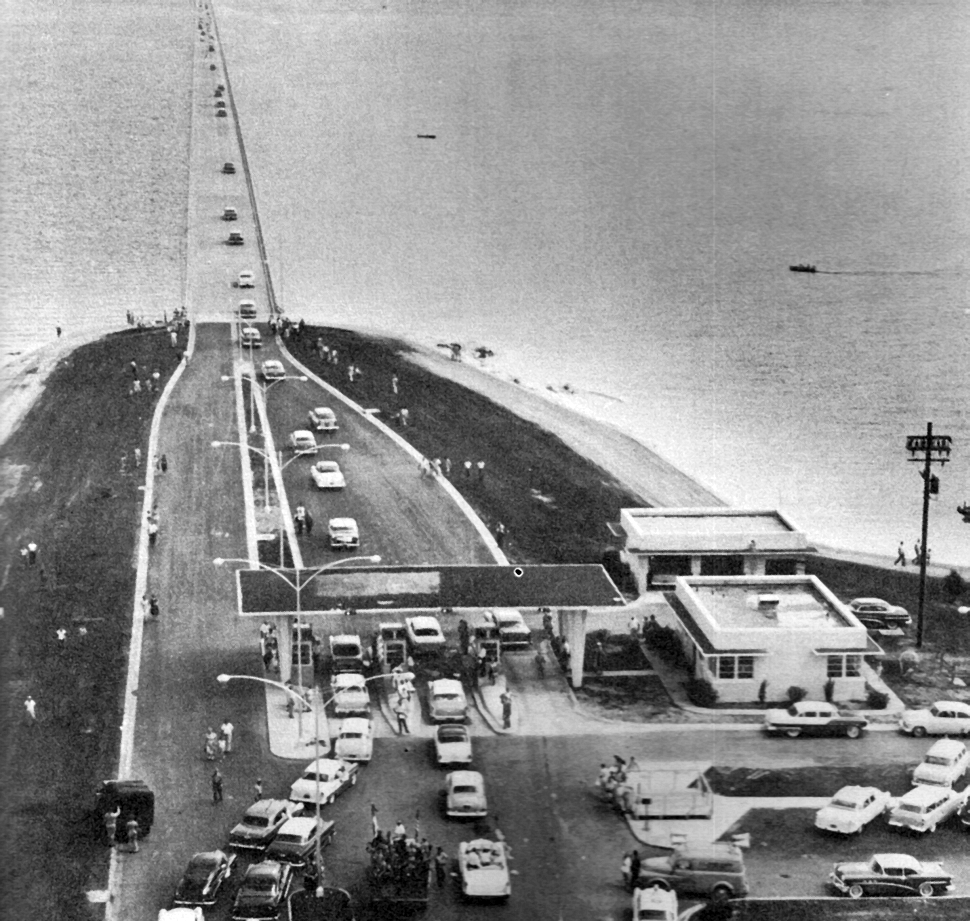
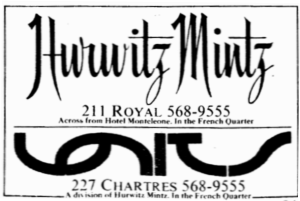 August 30, 1985 Times-Picayune advertisement for HurwitzMintz at 211 Royal Street and their Units
store at 227 Chartres.
August 30, 1985 Times-Picayune advertisement for HurwitzMintz at 211 Royal Street and their Units
store at 227 Chartres.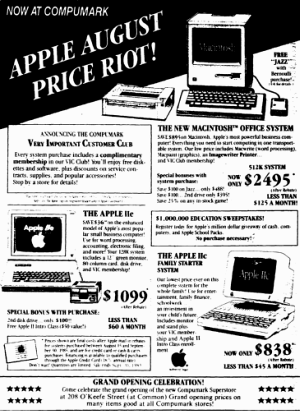 August 30, 1985 Times-Picayune advertisement for the new Compumark offering Apple computers at 208
O'Keefe Street.
August 30, 1985 Times-Picayune advertisement for the new Compumark offering Apple computers at 208
O'Keefe Street.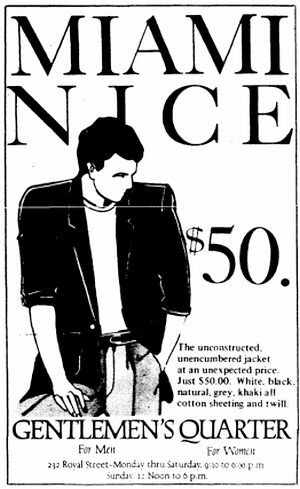 August 30, 1985 Times-Picayune advertisement for Gentlemen's Quarter ("For Men, For Women"
at 212 Royal Street.
August 30, 1985 Times-Picayune advertisement for Gentlemen's Quarter ("For Men, For Women"
at 212 Royal Street.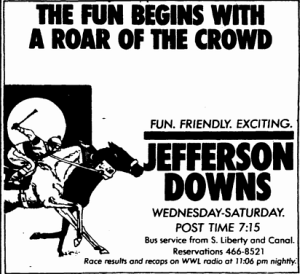 August 30, 1985 Times-Picayune advertisement for Jefferson Downs.
August 30, 1985 Times-Picayune advertisement for Jefferson Downs. 